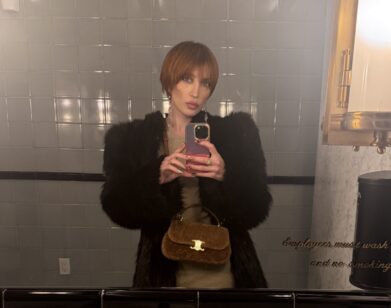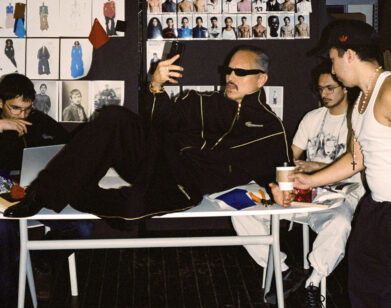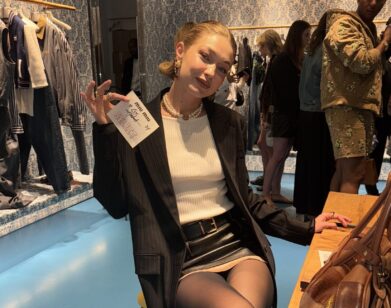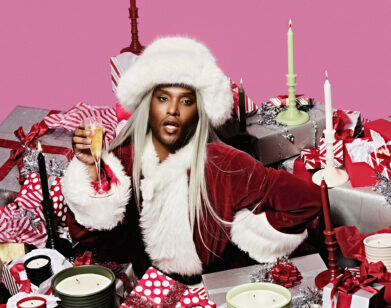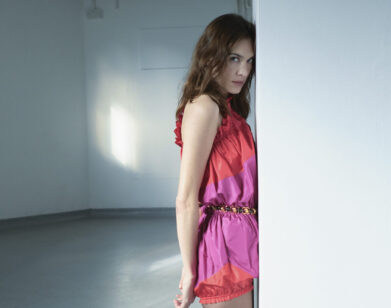Valentino
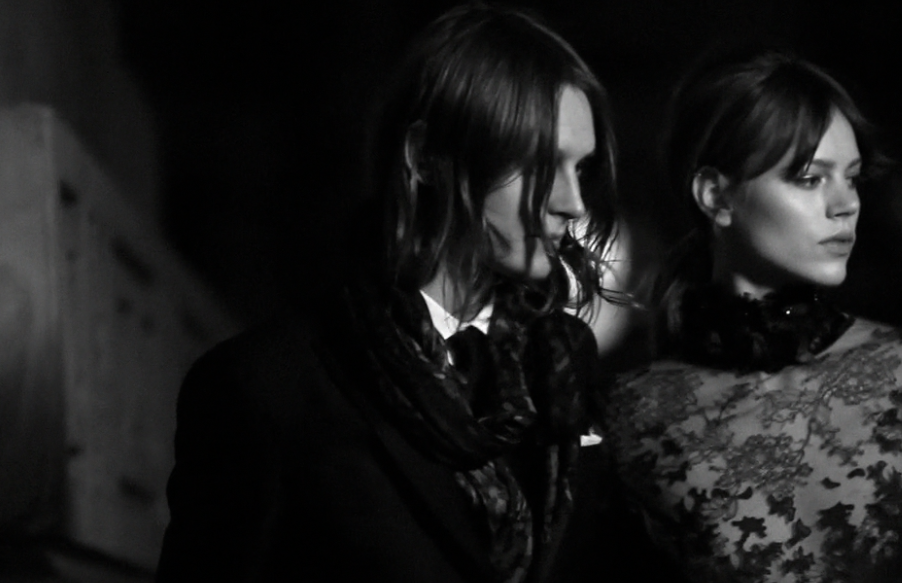
Valentino

If there is something most significant about Valentino, it’s that women feel beautiful when they’re wearing Valentino. Beauty is at the core of his work—it’s not just an element.Pier Paolo Piccioli
Since taking the reins two and a halfyears ago as creative directors at Valentino,designers Maria Grazia Chiuri and Pier Paolo Piccioli have faced numerous challenges—not the least of which has involved building upon the enormouslegacy of the legendary Valentino Garavani, who retired from the house that bears his name in January 2008. Mr. Valentino may have left his business, but he didn’t retreat from the fashion world and certainly not from his very active social life. Today Valentino’s imagecontinues to loom large, both figuratively and literally, over the fashion empire that he and his longtime business partner, Giancarlo Giammetti, built together over the span of nearly five decades.
Chiuri and Piccioli, who had previously served as accessories designers under Valentino for more than a decade, were appointed in 2008 following the brief run of Alessandra Facchinetti, who took over after Valentino’s retirement and promptly moved to etch out a new, very different image for the Valentino woman, but lasted just two seasons at the helm. In stepping in after Facchinetti’s departure, Chiuri and Piccioli were thrust into the position of having to determine the future of a brand at acrossroads. The journey has not been without some bumps along the way: a debut collectionthat some deemed too reverently old-school Valentino; another, an Avatar-inspired collection thatothers deemed not Valentino enough; and their ongoing struggle to carve out their own path as a design team—and working to reconcile that vision with the history of Valentino—in a very public way.

Recently, though, Chiuri and Piccioli have started to hit their stride. Their Fall 2011 collection, presented this past March in Paris, offered clear evidence of why they’ve quietly captured the hearts of Young Hollywood’s hippest girls (among them, this month’s cover girl, Michelle Williams, who wore Valentino to the Golden Globes), while creating a new language of grace and fragility in fashion—one that contains a delicate balance of romantic prettiness and edginess that has gently seduced women back into kitten heels, longer lengths, sheer layers, lace, ruffles, and bows—and a lightness of being that is quickly becoming the signature for the Valentino girl of the future.
The day after the show, Chiuri and Piccioli visited Giammetti at Valentino’s castle, Chateau de Wideville, in Davron, a half hour outside of Paris, to discuss the burdens of stepping into the shoes of their former boss, the Last Emperor, and how they think they’ve found a way to the future by looking into the past. Since taking the reins two and a half years ago as creative directors at Valentino, designers Maria Grazia Chiuri and Pier Paolo Piccioli have faced numerous challenges—not the least of which has involved building upon the enormous legacy of the legendary Valentino Garavani, who retired from the house that bears his name in January 2008. Mr. Valentino may have left his business, but he didn’t retreat from the fashion world and certainly not from his very active social life. Today Valentino’s image continues to loom large, both figuratively and literally, over the fashion empire that he and his longtime business partner, Giancarlo Giammetti, built together over the span of nearly five decades.
Chiuri and Piccioli, who had previously served as accessories designers under Valentino for more than a decade, were appointed in 2008 following the brief run of Alessandra Facchinetti, who took over after Valentino’s retirement and promptly moved to etch out a new, very different image for the Valentino woman, but lasted just two seasons at the helm. In stepping in after Facchinetti’s departure, Chiuri and Piccioli were thrust into the position of having to determine the future of a brand at a crossroads. The journey has not been without some bumps along the way: a debut collection that some deemed too reverently old-school Valentino; another, an Avatar-inspired collection that others deemed not Valentino enough; and their ongoing struggle to carve out their own path as a design team—and working to reconcile that vision with the history of Valentino—in a very public way.
Recently, though, Chiuri and Piccioli have started to hit their stride. Their Fall 2011 collection, presented this past March in Paris, offered clear evidence of why they’ve quietly captured the hearts of Young Hollywood’s hippest girls (among them, this month’s cover girl, Michelle Williams, who wore Valentino to the Golden Globes), while creating a new language of grace and fragility in fashion—one that contains a delicate balance of romantic prettiness and edginess that has gently seduced women back into kitten heels, longer lengths, sheer layers, lace, ruffles, and bows—and a lightness of being that is quickly becoming the signature for the Valentino girl of the future.
The day after the show, Chiuri and Piccioli visited Giammetti at Valentino’s castle, Chateau de Wideville, in Davron, a half hour outside of Paris, to discuss the burdens of stepping into the shoes of their former boss, the Last Emperor, and how they think they’ve found a way to the future by looking into the past.
GIANCARLO GIAMMETTI: So here we are, 12 years after we first met. If I remember correctly, we first met in a café on Piazza San Lorenzo in Lucina [in Rome]. You could say it was love at first sight because you both know I’ve always had great respect for you and, above all, I personally really like you. But thinking back to that day in the café, could you have ever imagined that one day you would be running a company like Valentino?
MARIA GRAZIA CHIURI: No! Absolutely not. It was unthinkable.
PIER PAOLO PICCIOLI: It wasn’t even a dream, in the sense that we were already delighted with our situation. I was working in a company for a brand that I liked, with Mr. Valentino, who was one of the best couturiers. It was already such an honor to design accessories for him.
GIAMMETTI: When did you realize, Maybe I could do that?
CHIURI: Frankly, when they offered us the job two and a half years ago. I was very scared, but not of the work—meaning, designing the collections. Personally what most concerned me was having to cope with the visibility. That really frightened me because everyone underestimated Valentino’s poise and ability to keep his cool.
PICCIOLI: It all happened very quickly. I had told my wife about it that day. When I received confirmation that evening, I was in Paris and I had to call home and also tell my mother. Who knows what she would have thought if she saw my picture in the papers the next day? When I told my mother that Alessandra [Facchinetti] was leaving and that they offered us the creative directorship position, my mother said, “You didn’t accept it, did you? Because if you do, you won’t see your children anymore.” I come from a family that isn’t ambitious and where other things are considered more important. But, of course, this was too great an opportunity, and I couldn’t say no.
CHIURI: Anyway, this job has many different aspects. It’s not just about designing the collection, but a global vision—you need to oversee communication and advertising and you have to manage your image and that of the company. Knowing how to juggle different jobs at the same time is what is most difficult.
GIAMMETTI: Valentino and I were perfect for all these jobs. But what I find interesting is that you didn’t want to copy us.
PICCIOLI: That would have been a hopeless task!
CHIURI: Maybe you don’t realize this because you established Valentino and were the owners for many years, but from the first moment we joined the company, we were at the service of the brand. We were not the brand, which is an anomalous situation in the fashion
industry and very egocentric.
PICCIOLI: There are also two of us. There were two of you, but in some way there was just Valentino, and you worked to keep him happy and you handled all the problems.
GIAMMETTI: Well, I also did some things on my own! I wasn’t just his super-assistant. [laughs]
PICCIOLI: That’s not what I’m saying. I’m saying that he was free to design the collection and not worry about advertising, the corporate vision.
GIAMMETTI: Let’s return for a moment to what you said about being at the service of the brand and not working for yourselves. The day after your show in Paris, there was an article by Ms. Suzy Menkes, who I greatly admire but who must have gotten up on the wrong side of the bed when she wrote it, because she said that the new collection lacks surprise. She said it was too safe and too close to the brand. Now, many of the journalists who write these things are the same people who complained when [John] Galliano’s or [Alexander] McQueen’s collections weren’t commercial enough. These fashion journalists are never satisfied. So how do you avoid being influenced by them?
PICCIOLI: You do analyze what you do and try to understand how others see you, but you do it from the right perspective and distance. We really admire Suzy Menkes because she always has an interesting point of view, and from her point of view, I don’t think what she said about us was so terrible. Today we believe that fashion needs consistency, so it wasn’t the right time for us to do a wild and crazy collection.
GIAMMETTI: Perhaps I’m slightly more skeptical and cynical. Unfortunately, the press—like many other sectors—wields such power today that if people aren’t strong enough, they tend to let themselves be influenced too much. I was able to stop Valentino from reading the newspapers and only tell him what they wrote. Perhaps Valentino was even more sensitive than you, but he was also more reactive than you, because he would have told those journalists to go to hell and would have banned them—as I did many times.
CHIURI: I have to say, with this [most recent] collection, the idea from the very beginning was not to do “editorial” things just for the sake of it. Not clothes that were a photo, but clothes. However, at the same time, we wanted classic fashion—meaning, when a customer enters the store, she finds a coat or dress that is made so well that it takes her back to what we consider fashion in the most traditional sense of the word. Because in recent years, the image of fashion has prevailed over traditional fashion, meaning sartorial detailing and workmanship. But fashion designing means creating something using a special technique that might not emerge in a photo, but when you look at it up close, you see that it’s stylish. That’s a cultural problem. Clearly we live in a time where image is more important than content.
PICCIOLI: I think it’s much easier to make a splash on the runway than to design collections that are valid on the runway but also in the stores. Designing a collection is not just producing clothes to satisfy your ego. The great designers—Valentino, [Yves] Saint Laurent—always thought of the women who wore their clothes. Fashion has created several disciples who have confused—
CHIURI: Their intent: to sell clothes for women.
PICCIOLI: It’s as if fashion looks at the women who wear it as less valid. Well, if I want to do something artistic, then I’ll make an art installation.
GIAMMETTI: What about the runway show? What good is a fashion show today?
PICCIOLI: A fashion show is good if the clothes last for more than six months, because if they’re boring or forgetful or crazy, then they’ll never hit the stores.
GIAMMETTI: Again, I’m more skeptical. Today, in this confusion where the Internet reigns, we saw your collection not the day after, but three hours after it appeared on the catwalk. Does the desire that fashion creates really last six months until the clothes are in stores? Does it last four months even? There is such a saturation of these things that I wonder if Tom Ford isn’t right not to do runway shows and to show his clothes in the magazines, because that’s what people want and where they remember them.
CHIURI: Well, he certainly found an innovative way to present his collection. But I think the real problem is that there is a saturation of brands that have no reason to exist. There are so many brands during Fashion Week that are clearly uninteresting.
PICCIOLI: But what Tom Ford is doing is also a form of packaging. It’s not just the fashion show—it’s a negation of the system used to communicate with the system. It’s another way to present your work.
GIAMMETTI: He’s a new phenomenon. He sells himself, and people buy things because he tells them to.
PICCIOLI: That’s packaging, though.
CHIURI: But I think he has built an image that is very close to what you did for Mr. Valentino. He has become the brand.
PICCIOLI: It is different because Tom Ford is the founder of his brand. His image and lifestyle coincide with the clothes he presents. Our fashion shows—and those of other brands in general—have to express something else. I think that what’s most interesting about Valentino, but also more subtle, is that it’s about the spirit of a certain type of woman. If there is something most significant about Valentino, it’s that women feel beautiful when they’re wearing Valentino. Beauty is at the core of his work—it’s not just an element. Therefore, capturing that spirit is much more subtle and profound a job.
GIAMMETTI: But it’s difficult for the person who takes his place to capture that.
PICCIOLI: It is difficult—and you can’t do it in just one season.
GIAMMETTI: What I found in the new collection was that I recognized each outfit not because it was a copy, but because it revealed the world of Valentino. Then there were some details that were much closer to the originals. I don’t think many people understand these things. They don’t say, “They were inspired by Valentino of the ’60s or of the ’70s or by Jackie Kennedy.” Even though Jackie Kennedy’s famous bridal dress was there twice, no one even mentioned that topic.
CHIURI: I’m sorry to have to say this, but I think that people don’t know much about the history of fashion.
PICCIOLI: As we were putting together the collection, we actually had a board with Jackie Kennedy, Patti Smith, Charlotte Rampling, and Marisa Berenson. What we liked was looking back at the past to create a collection that did not refer to a precise woman, dress, or collection, but instead, a precise spirit. That’s what we wanted. But conveying that spirit is often difficult because people don’t understand it. When you’re talking about beauty in the ’60s and looking at old photos . . . Marisa Berenson in that white outfit wasn’t a typical beauty for the time, but her aesthetic beauty was ahead of the times. Obviously, to capture the spirit of Valentino and update the concept of beauty, you have to look ahead and seek beauty in the individuality of a certain type of woman. Valentino’s spirit of the ’60s meant one thing, in the ’70s it meant something else, and today it may mean something different too.
GIAMMETTI: By which you mean . . .
PICCIOLI: Florence [Welch, of the band Florence and the Machine] on the red carpet was beautiful, according to today’s standards. Anne Hathaway is definitely gorgeous, but she isn’t an update.
CHIURI: For us, the Oscars were a summary of our perspective. Anne Hathaway was wearing a vintage Valentino, and Florence was wearing our couture dress. Both are gorgeous, modern women.
PICCIOLI: And both were equally valid.
GIAMMETTI: There was the collection you did that everybody thought was not very interesting because it seemed too much like a photocopy of Valentino. It was a couture collection [Spring 2009]. I was there with Valentino. When I came out after the show, I was a bit disappointed because I said it looked like Valentino, but not even a fresh version. I don’t know if you agree. Then there was the second collection that you did after that. Once again the press was very tough on you. You came out immediately afterward with a collection [Spring 2010] inspired by Avatar [2009], which was a completely different world from the previous one. But I really felt that both collections were not what I was expecting to see. How do you consider those two collections now?
CHIURI: I was very happy about that in the first collection. I think the first collection, in some way, expressed our love for the Valentino maison. Everybody said it was old-style Valentino, but I don’t think it was that—I think it was more in the image of Valentino.
GIAMMETTI: You told me that it was more a problem of editing the collection. The same clothes are worn today but the style is better.
CHIURI: Probably, but I honestly think that the dresses are not really old-style Valentino. I think there were beautiful things: the style, models, and ambiance were like old-style Valentino. But I also think that if we used the same dress now, nobody would say that.
PICCIOLI: At that moment, with that first collection, we were focused on designing clothes. We weren’t doing the job of creative directors yet. The collection featured some beautiful clothes, but the woman we presented on the runway was not our vision of the Valentino woman—she was the woman of Mr. Valentino himself. Of course, we don’t deny that we came after Alessandra Facchinetti, not immediately after Mr. Valentino. When Alessandra came in, she changed the vision of the Valentino woman, so at that moment, we felt we really needed to bring back the past of Mr. Valentino in order to move forward. We needed to reestablish something. It was a kind of starting point. I don’t think the clothes were so important, although some of them were beautiful.
GIAMMETTI: Why, then, did you completely forget the Valentino woman in the third collection?
PICCIOLI: I think the Avatar one was . . . Well, as you said, you love your children even if they are wrong. I think you also love your father, but sometimes you have to rebel before you grow up.
GIAMMETTI: What did that moment mean?
PICCIOLI: I think it was a moment in which we had to change. First, you have to go very close, and then you can go very far.
CHIURI: I’ll be honest: We were wrong. The accessories were wrong. The makeup was wrong. Sometimes we can be wrong.
GIAMMETTI: From my experience working with both of you, sometimes I clashed with two different people. Pier Paolo is more adventurous in what he wants to say and present. Maria Grazia, you are more matter-of-fact. Sometimes the two of you don’t agree with each other. But in this conversation, I think you both agree in all your answers. I haven’t heard a single different answer. Have you both calmed down a bit? Are you two more in sync now?
CHIURI: No, I wouldn’t say that. In some cases our differences have actually become accentuated. However, I think my practicality offsets his futuristic approach. I think if you take the best of both, then something good can come out of it.
GIAMMETTI: Can you do that without bloodshed?
CHIURI: We’re not violent and I hate arguing, so it wouldn’t come to that. But it’s still difficult.
PICCIOLI: It isn’t easy. However, at this point in time I think the future lies in the past, so in this moment—
CHIURI: We agree!
Giancarlo Giammetti is the honorary president of the House of Valentino. Together with Valentino Garavani, they founded the Valentino fashion house and he remained Valentino’s business partner for 48 years.


